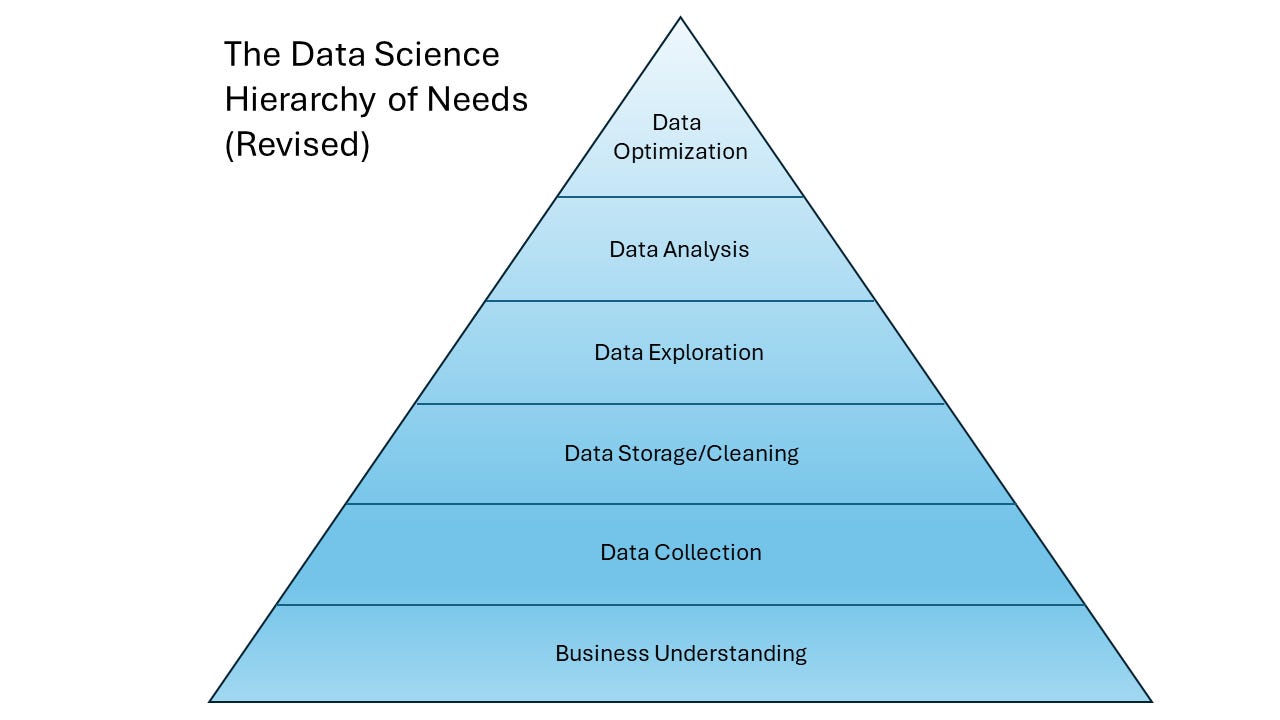The Data Science Hierarchy of Needs and Its Relation to the Data Science Lifecycle
As a follow-up to my article on the Data Science Lifecycle, the DS hierarchy of needs shows how the lifecycle phases ‘stack up’ to one another within the hierarchy layers.
(image by Carlo Carandang)1
In the rapidly evolving field of data science, understanding the basic, foundational elements and the progression to advanced analytics capabilities is crucial for organizations aspiring to leverage data effectively. The Data Science Hierarchy of Needs, as first conceptualized by Monica Rogati and inspired by Maslow’s Hierarchy of Needs, provides a structured approach to achieving data-driven insights and advanced analytics. I improve upon Monica Rogati’s DS hierarchy by adding business understanding at the bottom. My optimized DS hierarchy of needs aligns closely with the stages of the data science lifecycle, ensuring a systematic pathway from raw data to actionable intelligence.
The Data Science Lifecycle: Understanding its Importance for Data Mining and AI/ML Solutions
In the realm of data science, a structured and systematic approach is critical for achieving reliable and actionable insights. The Data Science Lifecycle provides a comprehensive framework that guides the process from understanding business needs to deploying sophisticated models. This article explores the key phases of the lifecycle and underscores its…
The hierarchy can be broken down into six key layers: business understanding, data collection, data storage/cleaning, data exploration, data analysis, and data optimization.
1. Business Understanding
Relation to Lifecycle: Business Understanding
At the foundation of the optimized Data Science Hierarchy of Needs is business understanding. This initial phase is critical as it sets the context and objectives for the entire data science project. It involves:
Identifying Business Goals: Clearly defining the problem to be solved and the desired outcomes.
Understanding Stakeholder Requirements: Gathering input from key stakeholders to ensure alignment with business needs.
Formulating Hypotheses: Developing hypotheses that can be tested with data.
2. Data Collection
Relation to Lifecycle: Data Collection
Following business understanding, the next layer is data collection. This phase involves gathering raw data from various sources such as transactional databases, IoT devices, social media, and web logs. Effective data collection requires:
Data Integration: Combining data from disparate sources to create a unified dataset.
Data Quality: Ensuring the accuracy, completeness, and consistency of the collected data.
Data Governance: Establishing policies and procedures to manage data availability, usability, integrity, and security.
3. Data Storage/Cleaning
Relation to Lifecycle: Data Preparation
Once data is collected, it needs to be stored in a manner that supports accessibility and scalability, aligning with the data preparation phase. The data also needs to be cleaned and prepared for analysis. Key considerations for data storage/cleaning include:
Data Warehousing: Centralized repositories that store structured data for analysis and reporting.
Data Lakes: Systems that store large volumes of unstructured and semi-structured data.
Cloud Storage: Utilizing cloud services to provide scalable and flexible storage solutions.
Data Security: Protecting stored data from unauthorized access and breaches.
Data Cleaning: Removing inaccuracies, inconsistencies, and duplicates from the dataset.
Data Transformation: Converting data into a suitable format for analysis.
4. Data Exploration
Relation to Lifecycle: Data Exploration
Data exploration is the process of examining large datasets to uncover initial patterns, characteristics, and insights, directly corresponding to the data exploration phases of the lifecycle. This stage involves:
Exploratory Data Analysis (EDA): Using statistical methods and visualization tools to identify trends, correlations, and anomalies.
Feature Engineering: Creating new variables or features that can improve the performance of analytical models.
5. Data Analysis
Relation to Lifecycle: Modeling and Evaluation
Data analysis involves applying statistical, mathematical, and computational techniques to extract meaningful insights from data, corresponding to the modeling and evaluation phases of the lifecycle. This stage encompasses:
Descriptive Analytics: Summarizing historical data to understand past behavior and outcomes.
Predictive Analytics: Using statistical models and machine learning algorithms to forecast future events based on historical data.
Prescriptive Analytics: Recommending actions based on predictive insights to optimize outcomes.
Machine Learning: Building models that can learn from data and make predictions or decisions without being explicitly programmed.
6. Data Optimization
Relation to Lifecycle: Deployment
At the top of the hierarchy is data optimization, where organizations continuously refine their data processes and models to achieve better results, mirroring the deployment phase. This stage includes:
Model Deployment: Implementing machine learning models into production environments for real-time decision-making.
Model Monitoring: Continuously tracking model performance and making adjustments as needed.
A/B Testing: Experimenting with different strategies to determine the most effective approach.
Optimization Algorithms: Using advanced techniques like genetic algorithms and reinforcement learning to improve decision-making processes.
Conclusion
The optimized Data Science Hierarchy of Needs provides a roadmap for organizations to build their data capabilities progressively. Starting from the foundational level of business understanding and data collection, moving through data storage, exploration, and analysis, and ultimately reaching data optimization, organizations can harness the full potential of their data. By addressing each layer systematically and aligning them with the stages of the data science lifecycle, businesses can develop robust data-driven strategies that drive innovation, efficiency, and competitive advantage.
If you're looking for support, here is how to contact me:
Coaching and Mentorship: I offer coaching and mentorship; book a coaching session here
Carlo Carandang, 2024, “The Data Science Hierarchy of Needs (Revised)”

